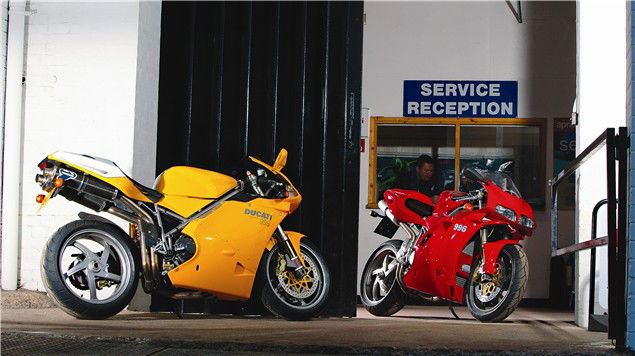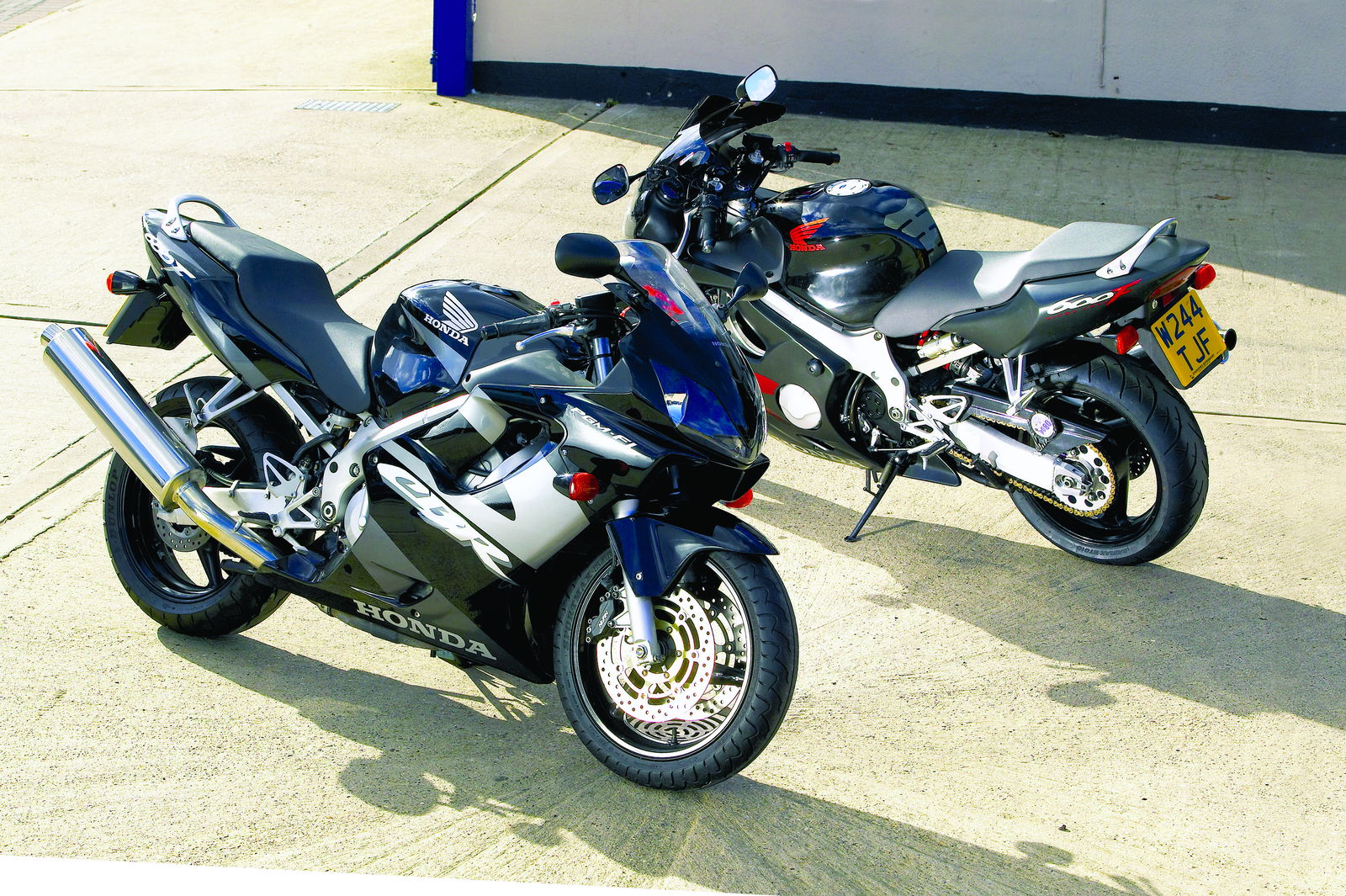Used Review: Ducati 916, 996 & 998
An aesthetic and performance revolution in its day, the 916 series has guaranteed iconic status for Bologna's blood-red bullets for time immemorial. But are those stories of Desmodromic histrionics all true?

 |
Carl Fogarty. The Aprilia RSV Mille. Neil Hodgson. The Honda VTR1000 Firestorm. James Toseland. Suzuki's TL1000. Troy Bayliss and, finally, Ducati themselves.
None of the above would either be here today or where they are today without the beautiful, seminal 916.
Developed in 1993 and launched in 1994, the 916 Strada was an astounding success. It had journalists spluttering for the superlatives and Foggy reaching for the World Superbike title in the bike's very first year of production. The 916 was a quantum leap forward.
Looks and performance-wise the bike was a winner. With lines from the pen of Massimo Tamburini and an eight-valve, liquid-cooled motor from the genius of Massimo Bordi, form and function hadn't been seen moulded together so perfectly since The Creation itself.
It wasn't the most powerful (100bhp at the wheel for a 916), it wasn't the lightest (around 200kg) and it could be agony to ride if you were anything but the perfect size for it, but the 916 was the most beautiful motorcycle then created and it's still the benchmark for two-wheeled exotica today.
Better still, it spawned a family of bikes which spanned a whole decade, as well as a host of imitators - although none of which came close to capturing the essence of the Ducati.
But two things were wrong with the 916. Firstly, it was too expensive and secondly, it was too unreliable.
Now, thanks to Old Father Time, the bike is available for upwards of £3500. And thanks to the Texas Pacific Group bikes produced after 1997 are much better built. This puts the 916/996 and 998 series well within the range of people with enough money in their pocket to buy a younger Jap four. Our advice? Choose wisely, know what model you're buying and check the bike's history.
Practicality
Poor. Ride one for a tankful and see how you feel. Make friends with a chiropractor. There's no under-seat storage, and even with the Biposto and some Halfords bungees, there's not a lot you can attach to the pillion seat
Front forks
Leaking fork seals can happen with any model, be it equipped with Showa or Ohlins. Check by holding the front brake on and pumping the front of the bike up and down. By running a finger up the leg, you'll feel excessive oily deposits. In general, the suspension front and rear will feel firm compared to a Japanese bike. That's just the way they are
Front brakes
Generally, the Brembos are pretty good. Any degradation of braking can be sorted with a strip and clean
Engine
A wonderful experience, even in 916 form. You've got about 100bhp from that liquid-cooled 90¡ V-twin. Sub- 3000rpm the engine is lumpy and throttle response harsh, but from 4000 it takes off up to 9000rpm. There's really no need to go beyond. It's lazy-feeling after a frantic four. Short-shift and keep an eye on the analogue speedo as the ton can come up way too fast! Service intervals Every 4-6000 miles. But do it every year
Alternators
Make sure the alternator locking nut is fully torqued up. If it comes loose it can lock the motor up. That could be both painful and pricey to fix
Cambelts
Asking when the belts were last changed is a must. If one fails the engine will need at best one head removing, at worse a complete rebuild
Rear cylinder gaskets
Have been known to leak on early 916s. Check for white spots around the rear shock. Don't ignore, as this can lead to buggered cranks!
Clutches
Ain't the strongest. Ask when the clutch was last changed on older, higher mileage Dukes. The hydraulic clutch slaves can fail, but this is a simple repair. A snatchy clutch can be improved by regular removal and cleaning. And don't be put off by the noise of the dry clutch - they're all like that
Cush drives
Have been known to come apart and chew the hub up, wearing the adjuster plate
Tyres
Michelin Pilot Sports are popular, but the favoured choice is the Pirelli Dragon Evo
Shocks
Some owners know nothing about setting the rear shock up, resulting in sloppy rear ends. It seems to be prevalent on the racier Ducatis. Use the manual and take everything back to standard after you buy. The standard settings are fine for most people who don't indulge on the track
Bip or SP?
Many Bips have SP parts fitted so be sure a converted bike isn't being passed off as a more expensive brother. The SP/SPS models have different engine parts and suspension and were usually supplied with factory-fitted carbon Termis. If you're buying an SPS or the like, you should get original, unused standard pipes and matching ECU chip
HOW MUCH, MISTER?
Ducati 916 Strada (1994)
Price new: £13,000
Pay now: £3500-£5500
Colours: red, silver/grey (Senna)
A classic is born. SP versions appeared every year, with uprated suspension (usually Ohlins) and number boards on the tail unit. Limited-edition specials like the Senna also popped up.
Ducati 916 Biposto (1997/98)
Price new: £12,800
Pay now: £4000-£6500
Colours: red/yellow
Pretty much the same as the Strada, save for the second seat. If you could call it that. Other minor changes came in 1998. Optional yellow finish. By now the SP version was sporting the 996cc motor.
Ducati 996 Biposto (1998)
Price new: £12,800
Pay now: £5500-£7500
Colours: red /yellow
The Bip gets the big-bore motor and, in 2000, five-spoke Marchesinis. The SP is revised to help Foggy win WSB and special-edition Foggy reps appear. In '01 the 996R gets a new cylinder head.
Ducati 998 Biposto (2002-2004)
Price new: £13,495
Pay now: £7000-£10,000
Colours: red/yellow
More ccs, but with the same good looks. The 998 flies the flag for a further two years to see out the full decade. The range is made up of Bip, 'S' and 'R' versions. Testastrettas are best 916-shape machine ever.

Carl Fogarty. The Aprilia RSV Mille. Neil Hodgson. The Honda VTR1000 Firestorm. James Toseland. Suzuki's TL1000. Troy Bayliss and, finally, Ducati themselves.
None of the above would either be here today or where they are today without the beautiful, seminal 916.
Developed in 1993 and launched in 1994, the 916 Strada was an astounding success. It had journalists spluttering for the superlatives and Foggy reaching for the World Superbike title in the bike's very first year of production. The 916 was a quantum leap forward.
Looks and performance-wise the bike was a winner. With lines from the pen of Massimo Tamburini and an eight-valve, liquid-cooled motor from the genius of Massimo Bordi, form and function hadn't been seen moulded together so perfectly since The Creation itself.
It wasn't the most powerful (100bhp at the wheel for a 916), it wasn't the lightest (around 200kg) and it could be agony to ride if you were anything but the perfect size for it, but the 916 was the most beautiful motorcycle then created and it's still the benchmark for two-wheeled exotica today.
Better still, it spawned a family of bikes which spanned a whole decade, as well as a host of imitators - although none of which came close to capturing the essence of the Ducati.
But two things were wrong with the 916. Firstly, it was too expensive and secondly, it was too unreliable.
Now, thanks to Old Father Time, the bike is available for upwards of £3500. And thanks to the Texas Pacific Group bikes produced after 1997 are much better built. This puts the 916/996 and 998 series well within the range of people with enough money in their pocket to buy a younger Jap four. Our advice? Choose wisely, know what model you're buying and check the bike's history.

